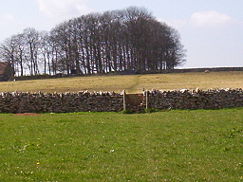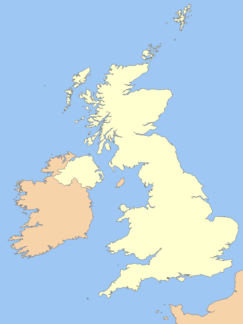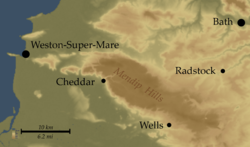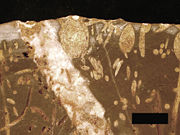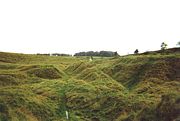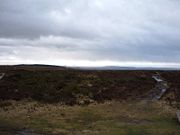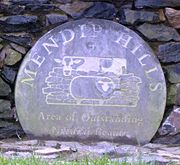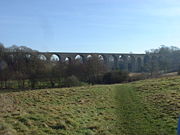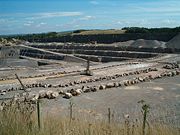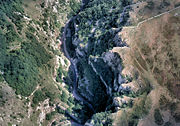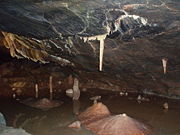Mendip Hills
2008/9 Schools Wikipedia Selection. Related subjects: Geography of Great Britain
| Mendip Hills | |
|---|---|
| Area of Outstanding Natural Beauty | |
|
The Mendip Hills
|
|
| Country | England |
| County | Somerset |
| Districts | North Somerset, Mendip, Sedgemoor, Bath & North East Somerset |
| Settlements | Wells, Cheddar |
| Location | |
| - coordinates | Coordinates: |
| Area | 200 km² (77 sq mi) |
| - SSSI | 25 km² (10 sq mi) |
| - Nature Reserve | 10 km² (4 sq mi) |
| - National Trust | 71 km² (27 sq mi) |
| Length | 30 km (19 mi), East-West |
| Width | 10 km (6 mi), North-South |
| Highest point | Beacon Batch |
| - coordinates | |
| - elevation | 325 m (1,066 ft) |
| Biome | Calcareous grassland |
| Geology | Limestone, Karst, Caves |
| Plants | Geranium purpureum, Galium fleurotii, Dianthus gratianopolitanus, Helianthemum apenninum |
| Animals | Peregrine Falcon, Long-eared Owl, Greater Horseshoe Bat, Downy Emerald, White-clawed Crayfish, Hazel Dormouse |
| Founded | 1972 |
| Managed by | Mendip Hills AONB Partnership |
| - location | Charterhouse, Somerset |
| - coordinates | |
| Website : www.mendiphillsaonb.org.uk | |
The Mendip Hills (commonly called The Mendips) are a range of limestone hills situated to the south of Bristol and Bath in Somerset, England. Running east to west between Weston-super-Mare and Frome, the Hills overlook the Somerset Levels to the south and the Avon valley to the north. The hills give their name to the local government district of Mendip, which covers most of the area.
The hills are largely carboniferous limestone, which is quarried at several sites. The higher, western, part of the Hills, has been designated as an Area of Outstanding Natural Beauty (AONB) which gives it the same level of protection as a national park. The AONB is 200 km² (80 sq mi). The Mendip Hills AONB Service and Somerset County Council's outdoor education centre is at the Charterhouse Centre near Blagdon.
The Mendips are home to a wide range of outdoor sports and leisure activities, many based on the particular geology of the area. It is recognised as a national centre for caving and cave diving. In addition to climbing and abseiling, the area is popular with hillwalkers and those interested in natural history.
Etymology
Several explanations for the name "Mendip" have been suggested. Its earliest known form is Mendepe in 1185. One suggestion is that it is derived from the mediaeval term "Myne-deepes". However, A D Mills derives its meaning from Celtic *monith mountain or hill with an uncertain second element, perhaps Old English yppe in the sense of upland, plateau .
An alternative explanation is that the name is cognate with Mened (Welsh mynydd), a Brythonic term for upland moorland. The suffix may be a contraction of the Anglo-Saxon hop meaning a valley. Two possible further meanings have been identified. The first is 'the stone pit' from the Celtic meyn and dyppa in reference to the collapsed cave systems of Cheddar. The second is 'Mighty and Awesome' from the Old English moen and deop.
Geology
The Mendip Hills are the most southerly Carboniferous Limestone Upland in Britain. The rock strata known as the Carboniferous Limestone were laid down during the Early Carboniferous Period, about 320–350 million years ago. Subsequently, much of northwestern Europe underwent continental collision throughout the late Paleozoic era, culminating in the final phases of the Variscan orogeny near the end of the Carboniferous Period, 300 million years ago. This tectonic activity produced a complex suite of mountain and hill ranges across what is now southern Ireland, south western England, Brittany, and elsewhere in western Europe.
As a result of the Variscan mountain-building, the area now comprises three major anticlinal fold structures, each with a core of older Devonian sandstone and Silurian volcanic rocks. The latter are quarried for use in road construction and as a concrete aggregate. 200 to 300 million years ago the Mendips were considerably higher and steeper than they are today. Since then, weathering has resulted in a range of surface features, including gorges, dry valleys, screes and swallets. These are complemented underground by a large number of caves, including Wookey Hole, both beneath the plateau and at the base of the southern escarpment. There are also limestone pavements and other karst features. Karstic dissolution of the limestone produced many of the gorges including, most famously, Cheddar Gorge and Burrington Combe. Springs, a number of which deposit tufa, are a particular feature of the eastern part of the hills.
The Devonian and Silurian rocks are generally more resistant to weathering and form some of the highest points on the hills, including the highest point at Beacon Batch on Black Down which is 325 metres (1068 ft) above sea level. Black Down is a moorland area, with its steeper slopes covered in bracken (Pteridium) and its flatter summit in heather (Calluna) and grasses rather than the pasture which covers much of the plateau. The main body of the range is an extended plateau, 6–8 km (4–5 miles) wide and generally about 240 metres (800 ft) above sea level.
In some areas the Carboniferous Limestone and the Dolomitic Conglomerate have been mineralised with lead and zinc ores. From the time of the Romans until 1908, the hills were an important source of lead. These areas were the centre of a major mining industry in the past and this is reflected in areas of contaminated rough ground known locally as "gruffy". The word "gruffy" is thought to derive from the grooves that were formed where the lead ore was extracted from veins near the surface. Other commodities obtained included calamine, manganese, iron, copper and barytes. The eastern area reaches into parts of the Somerset coalfield.
North and east of the Mendips, the same Carboniferous Limestone layers are found in the subsurface and are exposed in Avon Gorge, but younger strata overlie the Carboniferous Limestone in Dundry Hill and the Cotswolds, where the Oolitic Limestone of Jurassic age is found at the surface.
Climate
Along with the rest of South West England, the Mendip Hills has a temperate climate which is generally wetter and milder than the rest of England. The annual mean temperature is approximately 10 °C (50 °F) and shows a seasonal and a diurnal variation, but due to the modifying effect of the sea the range is less than in most other parts of the UK. January is the coldest month with mean minimum temperatures between 1 °C (34 °F) and 2 °C (36 °F). July and August are the warmest months in the region with mean daily maxima around 21 °C (70 °F). In general December is the dullest month and June the sunniest. The south west of England has a favoured location with respect to the Azores high pressure when it extends its influence north-eastwards towards the UK, particularly in summer.
Cloud often forms inland, especially near hills, and acts to reduce sunshine amounts. The average annual sunshine totals around 1600 hours. Rainfall tends to be associated with Atlantic depressions or with convection. In summer, convection caused by solar surface heating sometimes forms shower clouds and a large proportion of rainfall falls from showers and thunderstorms at this time of year. Average rainfall is around 800–900 mm (31–35 in). About 8–15 days of snowfall is typical. November to March have the highest mean wind speeds, with June to August having the lightest winds. The predominant wind direction is from the South West.
A combination of the rainfall and geology leads to an estimated average daily runoff from springs and boreholes of some 330,000 m³ (72 million imperial gallons). Bristol Waterworks Company (now Bristol Water) recognised the value of this resource and between 1846 and 1853 created a series of underground tunnels, pipes and aqueducts called the "Line of Works" which still carry approximately 18,200 m³ (4 million imperial gallons) of water a day to Barrow Gurney Reservoirs for filtration and then on to Bristol and the surrounding areas. All this is done by gravity as it collects and conveys water from the Chewton Mendip and East and West Harptree areas.
Ecology
There are three nationally important semi-natural habitats which are characteristic of the area: Ash- Maple woodland (Fraxinus spp. and Acer spp.) often with abundant small-leaved lime (Tilia cordata), Calcareous grassland and Mesotrophic grassland.
Much of the Mendip Hills is open calcareous grassland which supports a large variety of wild flowering plants and insects. Grazing by rabbits (Oryctolagus cuniculus), sheep (Ovis aries) and cattle (Bos taurus) maintains the grassland habitat. Some of the area is deciduous ancient woodland. Some of the area has been used intensively for arable agriculture, particularly since World War I. Some of this land is now being returned to grassland as the demand for arable land in Britain declines, but the use of fertilisers and herbicides have reduced the biodiversity in these areas.
Many bird species can also be found. Of particular significance is the Peregrine Falcon (Falco peregrinus) which has gradually recolonised the Mendips since the 1980s. It breeds on sea and inland cliffs and also on the faces of both active and disused quarries. The upland heaths of the west Mendips have recently increased in ornithological importance, due to colonisation by the Dartford Warbler (Sylvia undata), which can be found for example at Black Down and Crook Peak. In Britain, this species is usually associated with lowland heath. The woodlands at Stock Hill are a breeding site for Nightjar (Caprimulgus europaeus) and Long-eared Owl (Asio otus). The Waldegrave Pool, part of Priddy Mineries is an important site for dragonflies, including Downy Emerald (Cordulia aenea)(the only Mendip breeding site for this species) and Four-spotted Chaser (Libellula quadrimaculata). In 2007 the first confirmed sighting of a Red Kite (Milvus milvus) on the Mendips was made at Charterhouse.
A range of important small mammals are found in the area including the Hazel Dormouse (Muscardinus avellanarius) which is restricted largely to coppice woodland and scrub, Bats including the nationally rare lesser (Rhinolophus hipposideros) and Greater Horseshoe Bats (Rhinolophus ferrumequinum) which have a number of colonies in buildings, caves and mines in the area. A rare and endangered species, the greater horseshoe bat is protected under the Wildlife and Countryside Act 1981 and is listed in Annex II of the 1992 European Community Habitats Directive. Amphibians such as the Great crested newt (Triturus cristatus) have a wide distribution across Mendip and are often found in flooded disused quarries.
Several rare butterflies are also indigenous to the area. The Large blue butterfly (Maculinea arion) became extinct in the hills in the late 1970s, since which time a research project has been undertaken into the butterfly's ecology and reintroduction. Other species include the nationally scarce Pearl-bordered Fritillary (Boloria euphrosyne), Duke of Burgandy (Hamearis lucina) and White-letter Hairstreak (Satyrium w-album). The White-clawed crayfish is also nationally rare and a declining species with small populations in a tributary of the Mells River and the River Chew.
A well known Mendip feature is the dry stone walls which fragment the pasture into fields. Constructed from local limestone and in an "A frame" design, the walls are strong yet contain no mortar. Unfortunately years of neglect are allowing many walls to disintegrate, being replaced or contained by a mix of barbed wire and sheep fencing. These dry-stone walls are of botanical importance, supporting important populations of the nationally scarce Wall Whitlow-grass. Amongst the plants which occur in the area are the Cheddar pink (Dianthus), Purple gromwell (Lithospermum purpurocaeruleum), White rock-rose (Helianthemum apenninum), Somerset hair-grass and Starved wood-sedge.
History
There are twenty identified Palaeolithic sites in the Mendips, including eleven representing material recovered from cave sites, including faunal remains and lithic artefacts, and eight relating to surface lithic discoveries. The material found includes handaxes, points, and scrapers. Twenty–seven Mesolithic finds are represented by flint and chert lithics. There have been large numbers of artefacts from Neolithic, Iron Age and Bronze Age remains, including barrows and forts, such as those around Priddy and at Dolebury Warren. There is good evidence for 286 definite examples of round barrows within the AONB. There are at present over 1200 entries on the National Monuments Record (NMR) for the Mendip Hills AONB and just over 600 listed building records, including over 200 Scheduled Ancient Monuments. The caves of Cheddar Gorge in particular have yielded many archaeological remains as flood waters have washed artefacts and bones into the caves and preserved them in silt. The Cheddar Man was found here.
Settlement on the Mendip Hills appears to fall into two types. The first, apparent in the Neolithic and Bronze Age periods, and repeated on a small scale in the medieval and post–medieval era, comprised occupation by self-sufficient groups in small communities or isolated farms. The second was represented in the Iron Age and Roman periods by large sites with specialist functions, existing by virtue of their ability to exert power over lowland producers. From the Iron Age onward the ownership of land took on increasing importance, with large landholdings based on the mines or on stock grazing, denying settlers access to the plateau or forcing them off the hills.
There is evidence of mining dating back into the late Bronze Age when there were technological changes in metal working indicating the use of lead. The Roman invasion, and possibly the preceding period of involvement in the internal affairs of the south of England, was inspired, in part, by the mineral wealth of the Mendips. Much of the attraction of the lead mines may have been the potential for the extraction of silver; the Latin "EX ARG VEB" stamps on the Mendip lead pigs specify a de-silvering process and cast silver ingots have been found. The silver coinage of the Dobunni and Durotriges is also likely to reflect the availability of silver from the mines.
By the end of the medieval period a complex body of customary law had come into existence dealing with the four "Mendip mineries". That the medieval control was in the hands of the monastic foundations may indicate some continuity of tenure of large scale holdings, focused on the mines, from the Roman period.
When William Wilberforce visited Cheddar in 1789 and saw the poor circumstances of the locals, he inspired Hannah More to begin her work improving the conditions of the Mendip miners and agricultural workers. Between 1770 and 1813, 7,300 ha (18,039 acres) of land on the hills was enclosed, mainly with dry stone walls, which today form a key part of the landscape. In 2006 funding was obtained to maintain and improve the dry stone walls.
Over 300 "Mendip Motor Cars" were built by an engineering works based in Chewton Mendip in the years immediately before and after World War I. In World War II a bombing decoy was constructed on top of Black Down at Beacon Batch in an attempt to confuse bombers aiming to damage the city of Bristol, and piles of stones (known as cairns) were created to prevent enemy aircraft using the hilltop as a landing site. Other high points include Bleadon Hill, and North Hill near Priddy. The Mendip Hills are home to the Mendip UHF television transmitter installed in the 1960s, the tallest mast in the region, which is situated on Pen Hill near Wells.
Since 2003 arguments have raged over plans to erect a Wind Turbine near Chewton Mendip. The proposal was rejected by Mendip District Council, which enjoyed the support of a range of local groups and organisations, on the grounds that the environmental impact on the edge of the Area of Outstanding Natural Beauty outweighed the nominal amount of electricity which would be generated. In April 2006 a planning enquiry gave Ecotricity permission to build a 102 m (335 ft) turbine during the next year.
The Mendip Power Group are installing micro-hydroelectric turbines in a number of historic former watermills. The first to start electricity generation was Tellisford Mill, on the River Frome, which began operating in April 2007 and which is ultimately expected to produce 75 kW. Other mills in the Group, together with initial assessments of their capacity, include: Stowford Mill (37kW) and Shawford Mill (31kW), Jackdaws Iron Works (10kW), Glencot House (5.8kW), Burcott Mill (5.2kW), Bleadney Mill (5.4kW), Coleford Mill (6.6kW), Old Mill (5.2kW) and Farrants Mill (9.9kW).
Government and politics
The western end of the Mendip Hills have, since 1972, been designated as an Area of Outstanding Natural Beauty (AONB) under the National Parks and Access to the Countryside Act 1949. The Mendip Society which was formed in 1965, work to raise awareness of the designation and protect the area. The society now has 700 members and runs a programme of guided walks, educative talks and visits. The society also has a small grants fund to assist communities with the conservation and enhancement of the landscape and to encourage its enjoyment and celebration.
As they have the same landscape quality, AONBs may be compared to the national parks of England and Wales. AONBs are created under the same legislation as the national parks, the National Parks and Access to the Countryside Act 1949. Unlike AONBs, national parks have their own authorities, have special legal powers to prevent unsympathetic development. By contrast, there are very limited statutory duties imposed on local authorities within an AONB. However, further regulation and protection of AONBs was added by the Countryside and Rights of Way Act 2000.
The Mendip Hills Partnership, which has an administrative role, includes the five local authorities that cover the AONB, statutory bodies such as the Countryside Agency and English Nature together with parish councils and other organisations and groups that have an interest in the conservation and care of the area. The Mendip Hills AONB Service is the staff unit of the partnership, and is based at the Charterhouse Centre in the heart of the AONB. The AONB Service consists of six staff, a manager, development officer, planning liaison officer, two wardens and a support officer. They are supported by 50 volunteer rangers who give approximately 3000 volunteer hours each year. In 2005 a proposal was submitted to the Countryside Agency to extend the Area of Outstanding Natural Beauty to Steep Holm and Brean Down in the west and towards Frome in the east.
Many of the villages on the Mendips have their own parish councils which have some responsibility for local issues. They also elect councillors to district councils e.g. Mendip or Sedgemoor and Somerset County Council or unitary authorities e.g. Bath and North East Somerset, or North Somerset. Each of the villages is also part of a parliamentary constituency: Wells, Weston-super-Mare, or Wansdyke (which will become North East Somerset). The area is also part of the South West England (European Parliament constituency) of the European Parliament. Avon and Somerset Constabulary provides police services to the area.
Demographics
The population on the higher plateau is widely dispersed in small farms and hamlets, although many of the population in these settlements no longer work in agriculture or forestry but commute to surrounding cities and towns for employment. The largest villages on the plateau are Priddy and Charterhouse. The larger villages and towns are on the lower slopes of the western hills, often in river valleys. Axbridge, Cheddar, Shepton Mallet and Wells are along the southern border of the hills and Blagdon, Compton Martin and East and West Harptree along the northern edge.
Transport and communications
The ancient tracks across the hills were superseded in the middle of the first century by the Roman Fosse Way from Bath to Ilchester, which served the Charterhouse lead mines, and can be traced in some of the local place names such as Stratton-on-the-Fosse and Lydford-on-Fosse. Much of the high plateau remained uncultivated and unenclosed until the eighteenth century resulting in many roads remaining as narrow winding lanes between high banks and hedges or stone walls, which become open roads with wide verges in places which had their origins as drovers roads. The roads tend to follow the line of gorges and valleys as at Cheddar Gorge.
More major roads often started as turnpikes in the 16th century and are found avoiding the highest areas. To the north of the western part of the Mendips the A368 separates the hills from the Chew Valley, while on the southern edge the A371 similarly runs along the bottom of the scarp slope between the hills and the Somerset Levels. The western end of the hills is crossed by the M5 motorway and A38. Further east, and running almost north to south are the A37 and A39.
During the late nineteenth and early twentieth century the Bristol and North Somerset Railway ran roughly parallel to the A37 but this closed in 1965. Further south and west the Cheddar Valley line and Wrington Vale Light Railway, branches of the Bristol and Exeter Railway, served towns and villages from Cheddar to Wells. In the east, the Somerset and Dorset Joint Railway ran south from Bath into Dorset, and also served Wells. These have all now closed, although Mendip Rail has freight lines to carry limestone from the Quarries of the Mendip Hills. The Somerset Coal Canal reached some of the pits of the Somerset coalfield in the eastern end of the Mendips.
Quarrying
In recent centuries the hills, like the Cotswolds to the north, have been quarried for stone to build the cities of Bath and Bristol, as well as smaller towns in Somerset. The quarries are now major suppliers of road stone to southern England, between them producing around twelve million tonnes of limestone a year, employing over two thousand people and with an annual turnover of £150million.
There are two main rock types on the Mendips: the Devonian Sandstones visible around Blackdown and Downhead and the Carboniferous Limestones, which dominate the hills and surround the older rock formations. There are nine active and a host of disused quarries, several of which have been designated as Geological Sites of Special Scientific by English Nature. Because of the effect of the quarries on the environment and local communities, a campaign has been started to stop the creation of any new quarries and for restrictions to be placed on the existing ones.
Sport, leisure and tourism
The Mendips are home to a wide range of outdoor sports and leisure activities, including caving, climbing and abseiling. The rich variety of fauna and flora also makes it attractive for hillwalking and those interested in natural history. There are a range of tourist attractions including Cheddar Gorge and Caves, Wookey Hole and the small city of Wells.
There is a gliding club at Halesland Airfield between Draycott and Priddy. The Mendips Raceway is a popular venue for stock-car racing near Shipham. The Mendips are also home to several festivals including the Big Green Gathering, and a folk music festival and sheep fair in Priddy.
Caving and cave diving
The particular geology, within which large areas of limestone have been worn away by water, makes the hills a national centre for caving. Some of the caves have been known about since the establishment of the Mendip lead mining industry in Roman times. However, many have only been discovered or explored in the 20th century. The caves which are easily accessible to the public are at Cheddar Gorge and Caves and Wookey Hole, but specialist equipment and knowledge is required for the vast majority of the caves. The active Mendip Caving Group and other local caving organisations organise trips and continue to discover new caverns.
The Hills conceal the largest underground river system in Britain. Attempts to move from one cave to another through the underground rivers led to the development of cave diving, with Swildon's Hole being the site of the first cave dive attempt in Britain, in 1934. The first successful cave dive in Britain was achieved the following year at Wookey Hole Caves, where the last sump is currently the deepest in Britain at 76 m (250 ft). The cave complexes at St. Dunstan's Well Catchment, Lamb Leer and Priddy Caves have been identified as geological Sites of Special Scientific Interest.
Walking
Several sites on the Mendips are designated as open access land and there are a myriad of footpaths and bridleways which are generally clearly marked.
Several long distance trails cross the area including:
- Limestone Link 36 miles (58 km) path from the Mendips to the Cotswolds
- Mendip Way — 80 km (50 miles) long. From Weston-super-Mare to Frome. The western section runs from the Bristol Channel at Uphill Cliff affording views over the Somerset Levels. It crosses the central Mendip plateau leading down to Cheddar Gorge and then to Wells and Frome.
- Monarch's Way — 990 km (615 miles) long. From Worcester to Shoreham-by-Sea in West Sussex. It closely follows the route taken by Charles II after his defeat at the Battle of Worcester in 1651. The route enters Somerset near Chewton Mendip and crosses the Mendip Hills heading for Wells.
Mendips in the arts
Thomas Hardy described the Mendips as "a range of limestone rocks stretching from the shores of the Bristol Channel into the middle of Somersetshire", and several of his books refer to the Mendips or sites on the hills. Augustus Montague Toplady was inspired to write the words of the hymn " Rock of Ages" while sheltering under a rock in Burrington Combe during a thunderstorm in 1763.
In his 1995 novel Our Game, John le Carré uses Priddy Pools as the site for the drowning of one of his characters. The Mendips have been used as the location for various film and television filming including the use of Cloford Quarry as the main location used for the planet Lakertya in the Doctor Who story Time and the Rani. The 2007 film Hot Fuzz was largely filmed in Wells and the surrounding area.
